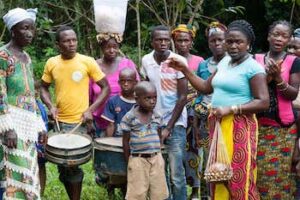
*The Mende people are celebrated on this date in 200. The Mende are one of the two largest ethnic groups in Sierra Leone; their neighbors, the Temne people, have roughly the same population. The Mende and Temne each account for slightly more than 30% of the country’s total population. The Mende are predominantly found in the Southern Province and the Eastern Province. In contrast, the Temne are found primarily in the Northern Province and the Western Area, including the capital city of Freetown. Some major cities with significant Mende populations include Bo, Kenema, Kailahun, and Moyamba.
The Mende belong to a larger group of Mande peoples who live throughout West Africa. Regional warfare throughout the 19th century led to the capture and sale of many Mende speakers into slavery. Most notable were Sengbe Piehis and those found aboard the Amistad in 1839. The Mende are primarily farmers and hunters. During the civil war, the Civil Defense Force (CDF), a militia group, was founded by Dr. Alpha Lavalie, a Mende himself, to fight the rebels and government troops. The forces included five groups drawn from all major ethnic groups in the country: Tamaboros, Hunters, Donso, Kapras, and the Kamajors. Kamajor is a Mende term for the hunter; they were not only the dominant warring factions but the most fearful among the CDF militias headed by late Deputy Minister of Defense, Chief Hinga Norman.
To date, the Kamajors are honored among the elite groups of men and women who fought to restore democracy in modern Sierra Leone. The Mendes are divided into Kpa-Mende, who are predominantly in the South - in Moyamba district, the Golah-Mende, from the Gola forest between Kenema and Pujehun districts into Liberia, a national reservation landmark, Sewa-Mende, who settled along the Sewa River, Vai-Mende also in Liberia and Pujehun district, Sierra Leone and the Koh-Mende who are the dominant tribe in Kailahun district with the Kissi (Ngessi) and Gbandi both of whom are in Liberia, Sierra Leone, and Guinea.
In the Americas, especially the United States, researchers have discovered that elements of African culture have been persistent for a long time. In some areas where there were large groups of enslaved Africans, they kept much of their heritage. In the 1930s, African American linguist Lorenzo Dow Turner found a Gullah family in coastal Georgia that had preserved an ancient song in the Mende language ("A waka"), passing it down for 200 years. In the 1990s, three modern researchers Joseph Opala, Cynthia Schmidt, and Tazieff Koroma — located a Mende village in Sierra Leone where the same song is still sung today. The story of this ancient Mende song and its survival in Africa and the US is chronicled in the documentary film The Language You Cry In.
The Mende traditionally live in villages of 70 to 250 residents, which are situated from 1.5 to 5 kilometers apart. There is little or no mechanization over the more significant part of rural Mende country. Mende farmers use hoes and machetes but few other tools. The Mende are generally known as growers of rice and several other crops, practicing crop rotation to protect soil productivity. Coffee, cocoa, and ginger are grown as cash crops, whereas rice, pepper, groundnuts, sesame seeds, and palm oil are grown for local consumption. Rice cooperatives have been formed in some rural areas. Traditionally, Mende farming has been carried out by labor groups organized locally and moving from farm to farm. Work is divided by gender: men attend to the heavy work of clearing the land for planting rice, while women clean and pound rice, fish, and weed the cultivated crops.
This routine is followed during ten months of every year, with a couple of months left around the New Year, when they can spend more time in the village engaging in domestic pursuits like house building. The Mende are a well-documented example of a non-western, pre-industrial society in which, at least historically, women took more political leadership positions relative to men. In the pre-colonial era, the Mende had female chiefs and war leaders. One such female chief, Madam Yoko, was the leader of the vast Kpa Mende Confederacy. The British formally recognized her as a Paramount Chief 1894, ruling an area eventually divided into fourteen chiefdoms.